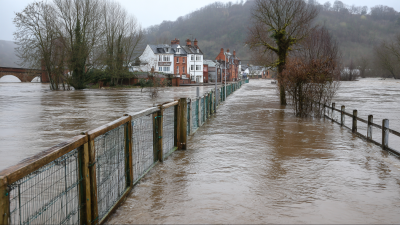Selecting the right flood pump is crucial for effective water management, especially in areas prone to flooding. According to a 2021 report from the National Flood Insurance Program, approximately 30% of flood claims originate from properties outside designated flood zones, highlighting the importance of preparedness for unexpected flood events. With varied types of flood pumps available, ranging from submersible to diaphragm pumps, it is essential to understand your specific needs and the characteristics of the flooding situation you may face. Data from the American Society of Civil Engineers indicates that efficient flood management can reduce property damage by up to 60%. Thus, choosing the right flood pump not only aids in mitigating damage but also ensures safety and peace of mind during emergencies. This guide will help you navigate your options, ensuring that you make an informed decision that aligns with your unique requirements.

When selecting a flood pump for your home, several crucial factors must be considered to ensure effective water removal and protect your property. First, assess the type of flooding you may encounter. According to the National Flood Insurance Program, over 90% of natural disasters in the U.S. result in flooding, highlighting the importance of choosing a pump suited to your specific conditions, whether from rainfall, burst pipes, or groundwater issues.
Another vital consideration is the pump's capacity and power. Flood pumps are rated by their flow rate, commonly expressed in gallons per minute (GPM). A report by the EPA indicates that a typical residential flood pump should handle at least 30 GPM for effective water removal during moderate flooding. Additionally, consider the depth of water you need to remove. Submersible pumps are ideal for deeper water situations, while pedestal pumps work best in shallower environments. Understanding your home’s unique flooding risks along with pump specifications will empower you to make an informed choice, safeguarding your property against water damage.
When choosing a flood pump, understanding the five essential types can significantly impact your decision. The first type is the submersible pump, designed to be submerged in water. These pumps are highly efficient for removing large volumes of water quickly and are often used in residential basements and flooded areas. Their design protects the motor from water, making them a reliable choice for deep extraction.

Next, we have the pedestal pump, which has a motor mounted above the water level. Suitable for shallow flooding, these pumps are easier to maintain since the motor is not exposed to water. However, they may not be as effective in very deep floods. Another option is the utility pump, known for its versatility and portability, often used for smaller jobs like draining a pool or emptying a small flooded area. Lastly, there are sump pumps, typically installed in a sump pit, which activates automatically when water accumulates. Choosing the right type of pump depends on the specific flooding scenario and your unique needs.
When selecting a flood pump, focusing on the right specifications ensures you make a wise investment to protect your property. Firstly, consider the pump's capacity, typically measured in gallons per hour (GPH). A higher capacity allows the pump to move water away more efficiently, critical during severe flooding events. Secondly, look for durability and construction materials. A pump made from corrosion-resistant materials will offer longevity, especially when exposed to harsh environments. Lastly, pay attention to the pump's power source. Electric pumps may be common, but options like gasoline-powered pumps can be vital during power outages, providing reliable performance when you need it most.

In addition to these key specifications, it's essential to examine the pump features that enhance convenience and usability. An automatic float switch is crucial, as it activates the pump without manual intervention, ensuring continuous operation as water levels rise. Furthermore, check for ease of maintenance, such as accessible filters and intuitive design for quick repairs. Investing in a quality flood pump with these specifications can act as a safeguard for your home, minimizing damage and ensuring peace of mind during flooding emergencies.
When selecting a flood pump, one of the most common mistakes is underestimating the flow rate required for your specific situation. Many individuals mistakenly believe that a lower capacity pump will suffice, but this can lead to prolonged flooding and property damage. It’s essential to assess the volume of water you may encounter and choose a pump that can handle peak flow levels efficiently.
Another frequent error is neglecting to consider the pump's durability and quality. Some buyers are swayed by lower prices, opting for cheaper models that may fail during critical times. Investing in a well-reviewed and robust pump ensures reliability during severe weather. Additionally, failing to account for the pump’s portability can hinder effectiveness; a pump that can be easily relocated may be necessary for those with varying flood risks in different areas of their property. Keeping these missteps in mind can significantly improve your flood management strategy.
This chart illustrates the popularity of various types of flood pumps based on their features and applications. Submersible pumps are the most favored due to their versatility and efficiency, while pedestal pumps and sump pumps also hold significant market shares. Understanding these categories can help you make an informed decision when choosing the right flood pump for your specific needs.
When investing in a flood pump, ensuring its longevity requires a commitment to regular maintenance. According to a report from the American National Standards Institute, approximately 25% of all pump failures are due to improper maintenance. Regularly checking the pump for any signs of wear or unusual noises can identify potential issues before they escalate into more significant problems. Moreover, ensuring that the pump’s inlet is free from debris and obstructions can enhance its efficiency and lifespan.
Following the manufacturer's guidelines for maintenance, which often include changing or cleaning filters and inspecting seals, is essential. The National Association of Home Builders emphasizes that a routine maintenance schedule can increase a pump's operational lifespan by up to 50%. Additionally, users should consider seasonal checks, especially before heavy rainfalls, to ensure that their flood pump is ready for use. By adopting these proactive measures, homeowners can significantly improve the performance and reliability of their flood pumps.
| Pump Type | Capacity (GPH) | Power Source | Weight (lbs) | Maintenance Tips |
|---|---|---|---|---|
| Submersible Pump | 3000 | Electric | 40 | Clean filters regularly |
| Pedestal Pump | 1500 | Electric | 30 | Check for blockages monthly |
| Sump Pump | 2200 | Electric | 35 | Inspect the floats regularly |
| Gasoline Pump | 4000 | Gasoline | 75 | Store in a dry place |
| Trash Pump | 2000 | Gasoline | 70 | Clean the impeller regularly |






Please enter the details to download, thank you
Get in Touch With Us
Please enter the details to download, thank you
Please enter the details to download, thank you
Please enter the details to download, thank you
Please enter the details to download, thank you
Please enter the details to download, thank you
Please enter the details to download, thank you
Please enter the details to download, thank you
Please enter the details to download, thank you
Please enter the details to download, thank you
Please enter the details to download, thank you
Please enter the details to download, thank you
Please enter the details to download, thank you
Please enter the details to download, thank you
Please enter the details to download, thank you
Please enter the details to download, thank you
Please enter the details to download, thank you
Please enter the details to download, thank you
Please enter the details to download, thank you
Please enter the details to download, thank you
Please enter the details to download, thank you
Please enter the details to download, thank you
Please enter the details to download, thank you
Please enter the details to download, thank you
Please enter the details to download, thank you
Please enter the details to download, thank you
Please enter the details to download, thank you
Please enter the details to download, thank you
Please enter the details to download, thank you
Please enter the details to download, thank you
Please enter the details to download, thank you
Please enter the details to download, thank you
Please enter the details to download, thank you
Please enter the details to download, thank you
Please enter the details to download, thank you
Please enter the details to download, thank you
Please enter the details to download, thank you
Please enter the details to download, thank you
Please enter the details to download, thank you
Please enter the details to download, thank you
Please enter the details to download, thank you
Please enter the details to download, thank you
Please enter the details to download, thank you
Please enter the details to download, thank you
Please enter the details to download, thank you
Please enter the details to download, thank you
Please enter the details to download, thank you